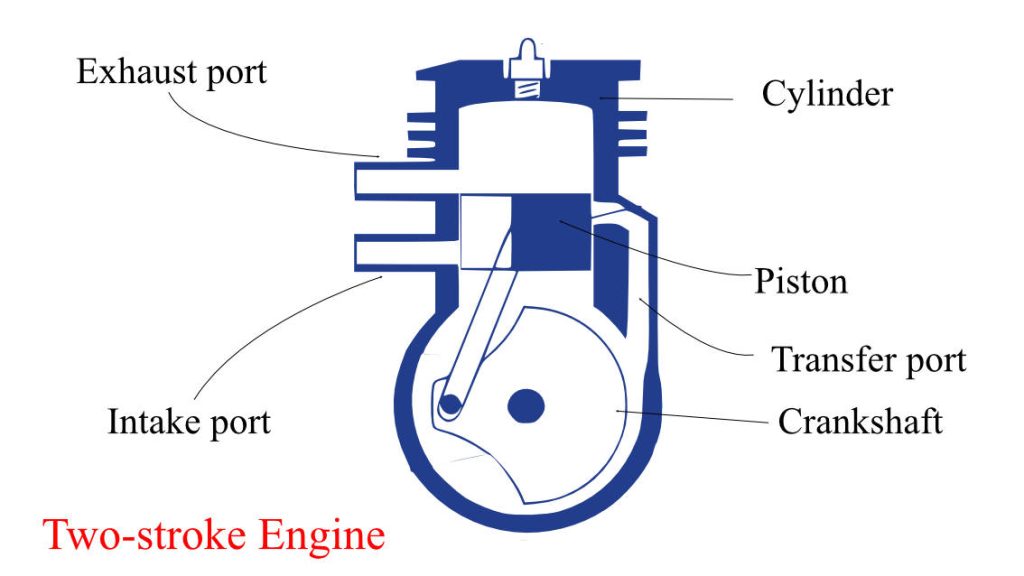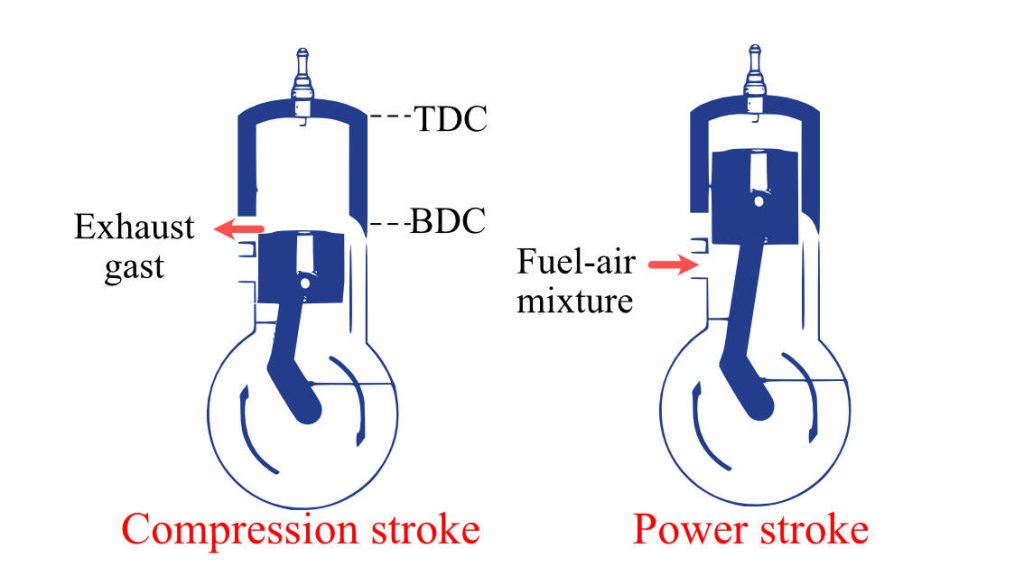An engine that is simpler yet still not widely used that’s the story of the two-stroke engine. Despite being easy to construct and simple to design, these engines come with serious efficiency issues. Why is it majorly limited to some applications, and why can’t it compete with its four-stroke counterpart? All these questions are answered with a detailed explanation of their working and limitations in this post.
Two Stroke engine
As the name implies, a two-stroke engine is a type of internal combustion (IC) engine that produces work in two strokes (i.e., up and down moment) of the piston. The piston travels up and down once, i.e., one revolution of the crankshaft, to complete its power or thermodynamic cycle. The history of these engines dates back to 1881, when it was first commercially released by Scottish engineer Dugald Clerk.
In the thermodynamic cycles of petrol and diesel engines, four processes include compression, heat addition, expansion, and exhaust. These four processes are carried out within two strokes, in a way that two processes are carried out in the upward motion of the piston, and two processes are carried out in the downward motion of the piston.
When comparing this with a four-stroke engine, you can easily see the huge difference in their construction. The lack of valves and cam-shaft makes these engines simple and lightweight.
Construction of Two-stroke engine
To clearly understand the working of the two-stroke engine, you need to see its main components. On the simplest level, these engines have a piston cylinder, crankshaft, ports, and spark plug or fuel nozzle.

The components that make these engines are:
- Piston-cylinder: Like any IC engine, these also have pistons and cylinders that contain the air-fuel mixture and transfer the energy to the mechanical rotation of the crankshaft.
- Crankshaft: It converts the reciprocating motion of the piston into the rotational motion. It also helps in the compression process.
- Spark plug or fuel nozzle: In a petrol engine, the spark plug ignites the fuel-air mixture. And in diesel engines, there is a fuel nozzle in place of the spark plug, which sprays the fuel inside the cylinder.
- Inlet and outlet ports: These act as openings from where the fresh air comes inside and the exhaust gases exit from the cylinder.
Working of Two-stroke engine
Like any petrol or diesel, the two-stroke engine works on a thermodynamic cycle. In case you aren’t sure which are these cycles, you can read the previous post on the Otto cycle and the Diesel cycle.
Overall, the two-stroke engine covers two strokes:
- Compression stroke: The upward motion of the piston opens the inlet port, and the air or air-fuel mixture enters the cylinder. The further movement of the piston compresses the mixtures. A spark plug ignites the compressed air-fuel mixture and initiates the power stroke.
- Power and Exhaust stroke: The burnt gas expands, thus exerting pressure on the piston. As a result, the piston’s downward motion begins, followed by the opening of the exhaust port. This removes the exhaust gases from the cylinder.

On a more precise level, the process of removal of exhaust gases and intake of air-fuel mixture happens simultaneously to some extent. And the compressed air-fuel mixture aids in the removal of exhaust gases. As a result, these two-stroke engines got their name crankcase scavenged two-strokes.
Application of Two-stroke engine
The smaller size and ease of maintenance make these engines the preferred choice in many cases.
The key application and advantages of these engines are:
- High power-to-weight ratio: The mechanical simplicity and high power-to-weight ratio of these engines are preferred in areas where weight is crucial.
- Work under different orientations: The traditional fuel-based lubricating system enables these engines to work under varying orientations.
Limitations of Two-stroke engine
Despite its compact size and simplicity, this simplicity comes at a huge cost.
Critical limitations of these two-stroke engines are:
- Low thermal efficiency: The unburnt air-fuel mixture gets rejected, thus reducing the efficiency.
- Incomplete combustion: The incomplete combustion and presence of exhaust gases in the fresh mixture lead to incomplete combustion.
- High vibration: These engines often generate high vibration at high speed.
Conclusions
Heat engines, especially internal combustion engines, are everywhere. One of those engines is the two-stroke engine which has lost its fame and application in time. At the time, when the world was thriving to become sustainable, these engines got a bad image because of their poor efficiency compared to their four-stroke counterpart. Despite all the negative it gets, it is still the preferred choice in areas where weight and size are major constraints.
Some key learnings from the post:
- Two-stroke engine: An IC engine that produces work in two strokes (i.e., up and down moment) of the piston.
- Strokes in a Two-stroke engine: There are two strokes that happen in a cycle; these are compression and power stroke.
- Advantage: The simple construction and light weight give them a high power-to-weight ratio.
- Limitations: These come with critical limitations like low thermal efficiency, incomplete combustion, and high vibrations.

Android Apps
⭐️ ⭐️ ⭐️ ⭐️ ⭐️ 1000+ | 400,000 + Downloads (Cumulative)
At eigenplus, our goal is to teach civil engineering students about structural analysis and design starting from the fundamental principles. We do this with the help of interactive android applications and accompanying web articles and videos.
Our apps have helped more than 400 thousand students across the world to understand and learn the concepts of structural engineering. Check out our apps on the google play store.